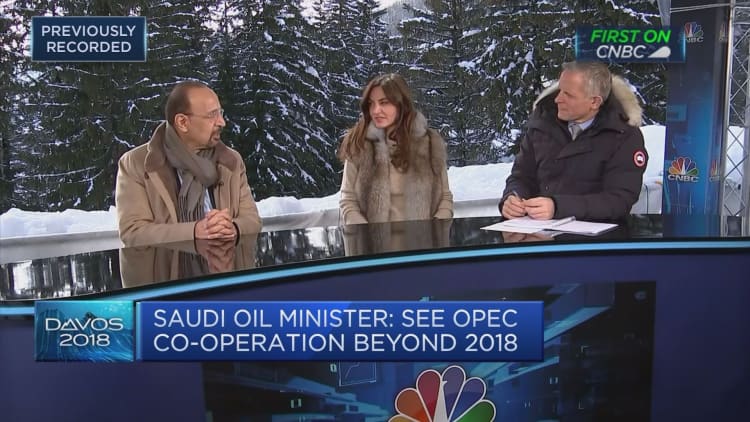Oil prices rose on Tuesday, with benchmark Brent crude hitting $70 a barrel for the first time in a week, boosted by healthy world economic growth prospects and expectations for continued production curbs by OPEC, Russia and their allies.
U.S. West Texas Intermediate (WTI) crude futures ended Tuesday's trade up 90 cents, or 1.4 percent, to $64.47 a barrel. WTI rose to its highest since December 2014 on Jan. 16 at $64.89.
Brent crude futures were up 82 cents, or 1.2 percent, at $69.85 a barrel by 2:23 p.m. ET, not far off the three-year high of $70.37 reached on Jan. 15.
The International Monetary Fund (IMF) on Monday revised upward its forecast for world economic growth in 2018 and 2019, to 3.9 percent for both 2018 and 2019, a 0.2 percentage point increase from its last update in October.
"The IMF's upward revision of its growth forecast is generating tailwind," Commerzbank analysts wrote. "This further improves the already fairly rosy demand prospects on the oil market."

This growth, which is also translating into more oil consumption, comes at a time of supply curbs by the Organization of the Petroleum Exporting Countries (OPEC) and Russia, which began in January last year and are set to hold throughout 2018.
Saudi Energy Minister Khalid al-Falih told CNBC on Tuesday that while he is "still anxious" about the fragility of the oil market, "we think we're on our way."
OPEC's main objective for the cuts is to eliminate a global surplus in oil stocks and rebalance the market. There is some expectation that OPEC will let the agreement expire at the end of 2018, but major producers have not yet suggested that this is in the offing.
In addition, the sharp plunge in Venezuelan production is offsetting increases from the United States, which is on the cusp of breaking its all-time production record of 10.04 million barrels per day.
U.S. Energy Department oil inventory figures will be released Wednesday morning; industry group the American Petroleum Institute will issue data on stocks Tuesday afternoon at 4:30 p.m. EST. U.S. stocks are expected to fall by 1.3 million barrels, which would mark a 10th consecutive week of declines.
Venezuela's output fell to a meager 2 million bpd in 2017, far short of expectations for 2.5 million bpd, and the International Energy Agency said it could keep declining in 2018.

"Six months ago there was a lot of consternation about how fast (U.S.) production might grow but that's been offset by Venezuelan volatility," said Tony Scott, managing director of analytics at BTU Analytics in Denver.
He added that with Saudi and Iranian production likely to remain steady throughout the year, it was hard to see an increase in supply that would undermine the rally.
French bank BNP Paribas said it expects inventories to rise near the end of the year. The bank raised its 2018 oil price forecasts by $10 a barrel, expecting WTI to average $60 and Brent $65.
But there have been signs of a possible price correction.
Crumbling refinery profits, first in Asia and now also in Europe and the United States, as a result of rising feedstock prices and plentifully available fuel products, point to lower crude orders going forward.
Barclays said it expected Brent to average $60 this year, $5 above its previous forecast, due to strong demand growth and falling output from Venezuela. But the British bank said it had "a bearish view on oil prices for the quarters ahead."

